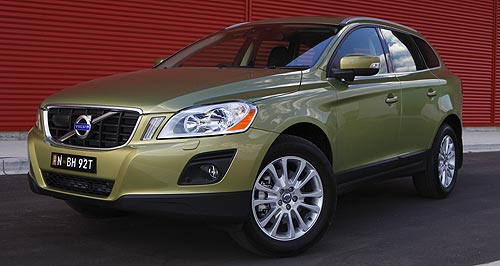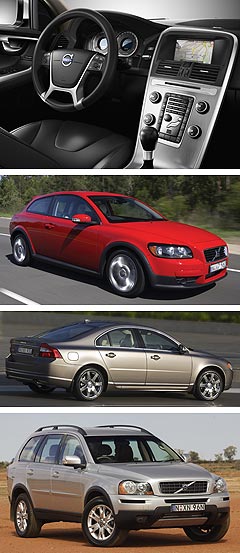Volvo XC60 goes front-drive
BY HAITHAM RAZAGUI | 10th Mar 2011

The XC60 T5 comes in at $54,150 – $3000 cheaper than the previous 3.2 AWD base model, which was already about $5000 more affordable than its two most direct rivals - the new X3 and this year's top-selling luxury SUV, Audi's Q5.
The XC60 update also features a refreshed interior and comes as part of a 2011 upgrade for the entire Volvo line-up (excluding the recently-released S60 sedan), accompanied by price increases of $500 for most models but not the XC70, C70 and C30, some versions of which are now $1500 cheaper.
Headlined by cleaner and in most cases more powerful Euro 5 emissions-compliant engines, the model year change brings a range of technical improvements as well as Bluetooth with audio streaming, Harman Kardon speakers, emergency brake lights and dedicated daytime running lights as standard across the Volvo range.
Powered by a 177kW Ford-sourced four-cylinder petrol engine that is closely related to the EcoBoost unit destined for the facelifted Falcon later this year, the new XC60 T5 consumes petrol at a rate of 8.7 litres per 100km and emits 207 grams of CO2 per kilometre.
The T5’s torque output is 320Nm and the 0-100km/h sprint is despatched in 8.1 seconds. Drive is fed to the front wheels via a six-speed dual-clutch transmission.

The petrol 3.2-litre six-pot lives on, driving all four wheels through a six-speed automatic transmission. Euro 5 tweaks result in a 5kW power increase to 180kW and 0-100km/h is done in 9.4 seconds while fuel consumption remains at 10.5L/100km and CO2 output is 245g/km.
Inside, a revised tunnel console and centre stack echo those of the S60 sedan, with a five- or seven-inch colour infotainment display depending on the specification level.
In terms of equipment, the XC60 in T5, 3.2 and D5 trim includes 17-inch alloy wheels, climate-control, cruise control, electric windows, heated retractable door mirrors and power-adjustable driver’s seat with memory, leather trim, rain-sensing wipers, rear-park assist and an eight-speaker CD/MP3 sound system with auxillary and USB inputs.
Top-spec T6 models, powered by a Euro 5-compliant revision of the company’s turbocharged six-cylinder petrol engine producing more power and torque than before while returning improved fuel economy and emissions of 10.5L/100km and 251g/km respectively, come with an interior air quality system, laminated side windows, power tailgate, heated front seats with power adjustment for the passenger side.
Buyers of the T6, D6 and 3.2 can upgrade to a similar level of equipment as the T6 by selecting the Lifestyle option pack, while all models have the option of a ‘Driver Support’ pack comprising upgraded adaptive cruise control, blind spot information system and lane departure warning.
A third ‘Teknik’ option pack includes satellite navigation, headlights that swivel with the steering, a rear parking camera, sound system upgrade and a compass integrated with the rear-view mirror.
The XC60, of which 1699 were sold last year to take a 6.9 per cent share of the luxury SUV market, is by far Volvo’s best seller in Australia – where in 2010 two thirds of the Chinese-owned Swedish brand’s sales were SUVs.
MY2011 changes for the rest of the Volvo range also include an upgrade to the adaptive cruise control, bringing it into line with the S60. The third-generation system warns the driver of an impending collision, pre-charges the brakes and then applies full braking force if the driver fails to react.
It also adds pedestrian detection and ‘Queue Assist’ which automatically regulates the vehicle’s speed in slow-moving traffic up to 30km/h.
The bodies of the V60, V70, XC70 and S80 have been strengthened between the A and B-pillars for improved pole-impact protection while the side curtain airbags have been recalibrated for improved sensitivity during front and rear-quarter collisions.
The rear head restraints have also been firmed up and moved forward slightly in a bid to reduce whiplash injuries.
The emergency brake lights automatically strobe to warn following drivers of heavy braking. When the vehicle slows to under 10km/h the hazard lights are activated. Afterwards they are automatically deactivated once the vehicle exceeds 30km/h if the driver has not manually switched them off.
The S40 sedan, V50 and V70 wagons now get the 20mm lower ‘dynamic chassis’ suspension as standard and the V70, XC70 and S80 have a mild interior refresh that features a new steering wheel and gearshift knob, ‘watch dial’ instrumentation and stitching on the door and centre armrests.
As is often the case when engines are upgraded to comply with the Euro 5 standard now compulsory in Europe, most Volvos have received extra power and torque as a side-effect.
The 3.0-litre turbocharged ‘T6’ six-cylinder petrol engine has increased in output from 210kW and 400Nm to 224kW and 440Nm. The torque output now equals that of Volvo’s 232kW 4.4-litre V8, prompting the company to drop the engine from its S80 luxury sedan – although the XC90 off-roader keeps the engine for now, which remains unchanged.
The T6 is also now cleaner and more economical thanks to friction-reduction techniques, upgraded spark plugs, electric power steering, regenerative braking, revised transmission programming and modifications to ancillaries like the water pump and air-conditioning compressor.
The D5, a five-cylinder 2.5-litre turbo-diesel, has received a software upgrade, boosting power from 136kW to 147kW and torque from 400Nm to 420Nm.
The C30 hatch, S40 sedan and V50 wagon now have the option of a ‘Lifestyle’ pack comprising leather upholstery, rear park assist, heated front seats with power adjustment for the driver and an upgraded sound system.
Most models now have a revised ‘Teknik’ option pack like that of the XC60. The C30, S40 and V50 also get blind-spot warning and rain-sensing wipers (with the S40 and V50 adding retractable door mirrors) while the C70 coupe convertible also adds keyless start. In addition to many of the aforementioned items, the V70, S80 and XC70’s Teknik packs also include adaptive cruise control.
Volvos sold 4945 in Australia last year, an increase of 5.9 per cent. The brand has sold 774 cars already this year, 16.2 per cent up on the same time last year.
| 2011 Volvopricing: | |
| C30 | |
| 1.6 DRIVe | $36,150             |
| T5 S | $36,950 (new model) |
| T5 S (a) | $38,450 (new model) |
| T5 R-Design             | $42,950 (-$1500) |
| T5 R-Design (a) | $44,450 (-$1500) |
| S40 | |
| T5 S (a) | $41,950 (+$500) |
| T5 R-Design (a) | $48,950 (+$500) |
| V50 | |
| T5 S (a) | $44,950 (+$500) |
| T5 R-Design (a) | $51,950 (+$500) |
| XC60 | |
| T5 (a) | $54,150 (new model) |
| D5 (a) | $60,450 (+$500) |
| D5 R-Design (a) | $64,650 (+$500) |
| T6 | $66,450 (+$500) |
| T6 R-Design (a) | $70,650 (+$500) |
| XC70 | |
| 3.2 (a) | $59,950 |
| D5 (a) | $61,950 |
| C70 | |
| T5 S (a) | $61,950 |
| T5 (a) | $69,950 |
| XC90 | |
| 3.2 (a) | $69,950 |
| 3.2 R-Design (a) | $74,450 (+$500) |
| 3.2 Executive (a) | $75,950 (+$500) |
| D5 (a) | $72,950 |
| D5 R-Design (a) | $76,950 |
| D5 Executive (a) | $78,950 (+$500) |
| V8 R-Design (a) | $89,950 (+$500) |
| V8 Executive (a) | $91,450 (+$500) |